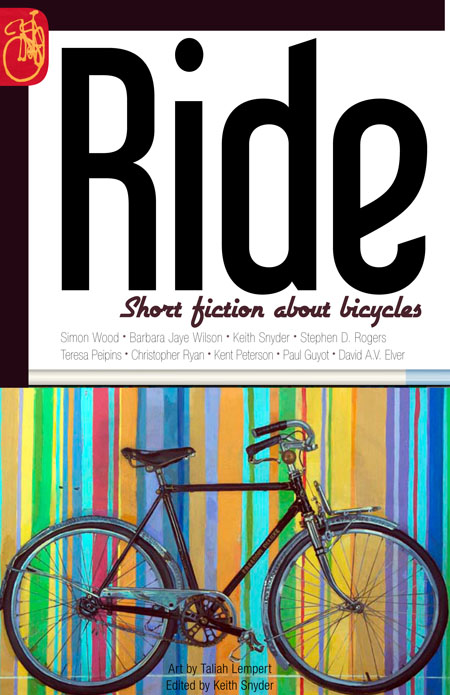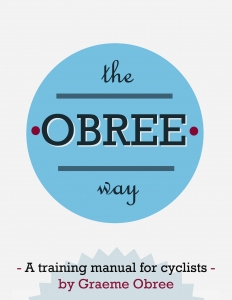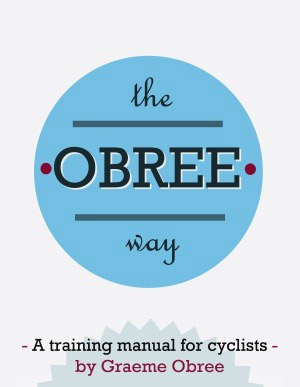The Obree Way and Ride – Short Fiction

Ride – Short Fiction about Bicycles
I remember reading a blog post from a local cyclist indicating his frustration with running into acquaintances and all they could talk to him about was of the ‘so, I hear you ride your bike a lot" variety. Riding a bike is funny that way. It has a way of being all encompassing, a way of defining who you are in a way that it is unlike most other activities/passtimes/hobbies (I know, I know, how dare I call it a hobby?!) that I know of. As racers, we spend recklessly, obsess over our nutrition, shave our legs, and substitute very early mornings for late nights. As commuters, we carry changes of clothes, pay too much attention to the 10 day forecast, and meet our friends in bars clomping around on what sound like tap shoes (and don’t have much traction to begin with, let alone on a beer soaked floor, with one or two in your system). The types go on and on, each with their own distinct brands of neuroses. The point is not that we are neurotic (we are) but that the binding common element is that we are all about the bike. These lifestyle changes are function over form. The bike occupies our thoughts and our conversations, especially with like minded souls. The theme of "bike" is an obvious thread that runs throughout these nine short stories, but more importantly, identity is at the heart of many of these (fear not, Derek Parfit will not be discussed), perhaps most obviously in the chilling "I’m Bob Deerman." I found the contribution by the editor of the book, Keith Snyder, to be especially poignant and his story, as well as the shop talk in Christopher Ryan’s are the most seamless examples of bicycles serving the story effortlessly. There is a nice bit of cathartic revenge fantasizing done by Simon Wood. Kent Peterson’s contribution is an unabashed love letter to biking, which is welcome, and Taliah Lampert’s illustrations are wonderful, as always. A satisfying read when your brain needs a break from training, but you just can’t seem to stop thinking about the bike.
Available on Kindle, and coming soon to Nook and iBook
The Obree Way – A Training Manual
On the other end of the spectrum of cycling reading material is Graeme Obree’s "The Obree Way." This highly personal work from one of cycling’s most intriguing figures is, as named, a training manual of sorts, probably the most unique training manual I have ever come across, and a fascinating read from this world class athlete. It is, not surprisingly, aimed squarely at cyclists, with exceedingly specific instructions on everything from bike fit to breathing techniques to coping with disappointing performances. I would venture to say that other athletes could benefit from Graeme’s mental approach to training and mental preparation for competition.
For those of you unfamiliar with Mr. Obree’s life story, I encourage you to become familiar, he is a remarkable individual, to say the least. The subject of a feature length film, "The Flying Scotsman," and the author of a compelling autobiography, he has struggled throughout his life with depression, among other things, and is a very open and honest figure in a sport riddled with it’s fair share of secrecy. His reimagining of the rider’s position on the bike has been hugely influential, as has his fabrication of bicycles and components.
A large part of "The Obree Way" is dedicated to the setting up of a proper training bike. Like everything, this is done down to the finest detail, and, as in other parts of the manual, requires some work on the part of the reader/athlete. At times, there is a bit too much detail, if possible, and leads to some confusing bits (for instance, the equation he advises to use for crank length came up with an impossible number for me, but that may be my poor excuse for a brain). There is so much detail, in fact, that he even offers up advice on how to deal with your significant other in terms of the time commitment necessary to be successful, for that is who this book is aimed for, those who are willing to do whatever it takes to succeed. While there are bits that the casual cyclist will benefit from (hell, the breathing technique was helpful even on my daily commute), the book, like Obree, is intensely focused. Personally, I am a huge fan of Graeme Obree’s and his accomplishments on and off the bike and definitely recommend "The Obree Way," for all cyclists, just be forewarned, it’s not your average training manual.




I bet the crank length equasion gave you a number over 200mm? They all do for me. Tables never do, equasions always.
I’m an Obree fan myself, met him once when he was proudly presenting his own line of Scottish-made handlebars and add-ons on a bike exhibition. Gotta love free thinkers who choose to innovate. I try to be like him, in the good ways. Need to check out the movie and book I suppose.
Make your hard days harder, and your easy days easier. You’ll go faster.
Someone somewhere thinks that visitors to this site have an unquenchable thirst for Uggs.
We interviewed Obree a while back, he was one of my favorite interview subjects.
https://nyvelocity.com/content/interviews/2007/graeme-obree
That was a lovely review to wake up to. Thank you.
RIDE is now available for both Kindle and Nook, with iBooks coming as soon as they get around to approving it. There have been delays on the print version, so it won’t be here in time for the holidays, but it should exist pretty soon after that.
Links to the different versions (as well as story previews) can be found at the RIDE blog:
ridebikefiction.wordpress.com
Thanks again for the review!
thanks Will, great reviews. was really looking fwd to the obree book when he first started tweeting about it, especially curious about the chapter on breathing techniques so thanks for mentioning it!
Here’s an excerpt on breathing. I’d probably fall over if I tried it.
http://dailycycle.co.uk/post/2011/11/23/A-master-class-in-Breathing-from-Graeme-Obree.aspx
I’ve been using the same breathing pattern for a long time, I’m not sure it would be possible to change it. I wonder if anyone reading this has tried it successfully?
I can see it now: the entire excitable peloton rolling around central park breathing like a lamaze class. Whooooooooosh!
More weirdness – all this stuff could be easily tested (and probably has been) in controlled experiments and all of it would be found to be utter crap.
Obree was great – no doubt about it. But it was because he trained hard and was physically and mentally strong as hell.
The only studies worth paying any attention to are studies done on trained cyclists and the study should have a control (untreated) group.
Myth – Stretching Prevents Injuries
Truth – wrong no evidence to back this up
Myth – Running barefoot is better for the body
Truth – It all depends you your body type and discipline
Myth – You need to focus on your core to become a better athlete
Truth – Fasle, core strength focus is over rated.
Myth – Guzzling water and electrolytes before a race prevents cramps
Truth – Water and electrolytes have little to do with muscles seizing up.
Myth – Popping ibuprofen before a hard workout prevents sore muscles afterward
Truth – It does more harm than good
Myth – Dehydration hurts race performance
Truth – Overhydrating is more likely to sabotage your performance
Myth – Ice baths speed recovery
Truth – They are not worth the chill, only a placebo effect
Myth – Long and slow is the best way to burn calories
Truth – Wrong, you need to pump up the intensity
Myth – Fructose is a performance killer
Truth – Wrong, fructose can be a performance super fuel
Myth – Supplements take performance to the next level
Truth – There is no such thing as a magic pill (at least not a legal one)
Myth: like any of this shit matters.
Truth: like any of this shit matters.
I am looking at this wrong…Obree’s book is something like $60? For that much coin the least he could do is put up some excerpts.
I don’t know if I would call it “successfully” but I have been trying to incorporate this technique for about the past month and feel like it helps a bit. No evidence to back it up, and it may just be that it has me more aware of my breathing, but I like it, and it actually becomes fairly easy once you get into a rhythm.
Too much hype in cycling.
How much can breathing technique change? Don’t you breath in and then exhale, it comes naturally!
Oh by the way, if you wear stockings while riding, it increases power output and endurance by 500% and removes lactic acid 1000% faster. Give it a try.
Myth – ‘Myth/ Truth’ lists dispense useful and scientifically accepted facts.
Truth – They are mostly contrarian tripe for anti-science tea bagger types.
Example:
Myth – The Earth is round.
Truth – Since the Earth isn’t perfectly geometrically round, it could be categorized as flat.
If you wear stockings over your head while winter training, you’ll race better by June, guaranteed. Must use control top hose though.
also, try training whilst holding your breath, you body will become better at buffering lactate. great for HIT intervals, only force breathing during recovery period…
Yes, it did, way over 200.
his autobiography is a stark yet excellent read.
we don’t?
BTW I saw the movie now, and I almost needed a hanky, for various scene. I really seemed able to relate to the main character. What a man!
You need crank proportionate to your leg length, and make up. Foot length and femur length are part of the equasion. Whether you’re a pusher or spinner make be part of it.
Anyway, between a stubby legged 5’3″ climber and all-legs 6’4″ me (there are taller pro’s out there), there are dozens of procents. Between the commercially available, there is 6%. 170mm to 180mm. You need to be quick lucky to get either, on a stock bike.
Miquel Martinez is a tiny climber and liked his 175’s. No way 200m would suffice me.
There have been many controlled experiments with cranks, which IMO all lacked one huge factor: TIME. Cyclists are conditioned. Cranklength is a HUGE factor for your muscles, even seating position. When I went to 195mm cranks, I was struggling to get my MTB set up for the 15mm change.
I had a customer, 6.8″, 40″legs. Rode 175’s of course, tiny 26″er. I designed a 29″er for him,a nd commissioned it from a Czech factory. This is 2003 or so we’re talking here. He got (conservative) 195mm cranks for it, and the frame was prepared with a taller BB to match. After 4 weeks of very frequent riding, he was totally ready to got back to 175mm. Then all at once, they “clicked for him”. He went from being the slow one on his group rides, to waiting on top of glaciers for all the others. A 100kg monster outclimbing the lot of them, much more experience riders. He was a recent addition to the group.
Yet, a friend of mine, avid rider and my build, went from usual 180’s (on all his many bikes) to 200mm on a custom bike. He was lucky. His maiden ride was the Singlespeed Worlds in the US. He found himself climbing with greater ease (out of saddle on a SS), and reaching the same spin rpm’s. Yet, he’d adjusted his gearing by 10% to account for added leverage. So, he ended up spin-coasting the flats faster, on a bike with similar or better climbing performance. He had no adjustment period, at all. Instant advantage.
Me, I needed to get used to the longer cranks. Which was hard, having them on just one bike, which was not really a race bike, and logging miles on bikes that could not accomdate 195mm.
Since long cranks (steep knee and hip angles, large range of motion) require adjustment, subjects tend to perform better with short cranks. Get the power from the spin, rather than from the strength.
If you look well, you’ll see short riders in 175’s really turn those cranks. Their relative low rpm helps them pedal nice and round. Try pedal nice and round if you have 40″ legs and short cranks, at high rpm.
Considering Martinex used 175’s when he could havee had 170’s, he could have been close to his optimum. Larger riders hardly ever get to even try a bike of similar proportions for size, let alone for a month of non-stop adjustment. You really never know until you try, and go through that (painful and frustrating) adjustment time. Yeah, it may take a special frame and really rare cranks. Thanks to Shitmano and the standardization gang.
One-size-for-all cranks WORK, because we could turn 100m or 300m if we had to. There are trade-offs for long and short, and the optimum doesn’t bring you handsful of percents of power output. It’s subtle, but it can make a real difference if you’re sensitive to it.
thanks, but that doesn’t take banking/pedal strike into account, and the # I came up with was way over 200. But, again, it is probably my lack of a brain.
Who needs a crank when you can put a battery and motor on the bicycle?
The other day, while I was at work, my cousin stole my iPad and tested to see if it can survive a twenty five foot drop, just so she can be a youtube
sensation. My iPad is now broken and she has 83 views. I know this is entirely off topic but I had to share it with someone!
my site; Information
It was an interesting reference of bicycles. I have a feel that you might have a different experience riding your bike and that should have prompted you to write a briefing on it. I also had similar challenging experiences; however, I love to ride my bike with the same passion as before. *** snore stop ***